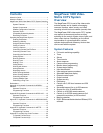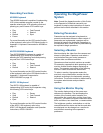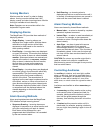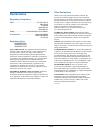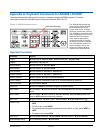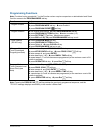
MEGAPOWER CPU 8200-0421-02, REV. E
OPERATOR’S GUIDE
5 of 21
Figure 3. Local monitor screen display
0001
HOLD
MAIN
ENTRANCE
12-15-04
10:27:56
a. Camera Number
b. Monitor/Camera Status Indicator
c. Camera Title
d. Current Date
e. Current Time
Calling a Camera
After a monitor has been selected for control of the
keyboard, the operator can “call” a camera to view
and control. Each camera in the system is
identified by a unique number that is used when
calling it. It is necessary to call cameras for certain
programming functions as well.
Locking a Camera
After calling a camera to a monitor, an operator
can lock the camera to prevent other operators
from taking control of it. This feature can be
particularly important when actively following a
suspect or investigating an area of interest.
When another operator calls a locked-out camera,
the designated camera video displays on the
monitor, but will not respond to that operator’s
controls. The message, “LCK KXX,” (where XX is
the number of the keyboard that has the locked-out
camera) is displayed on the monitor to let the
operator know the camera is locked out.
The default status of all cameras is unlocked.
Controlling Camera Pan/Tilt/Zoom
Operators can control the pan/tilt/zoom (PTZ)
movements of motorized cameras and domes
using the joystick or a similar device on the
keyboard.
• Pan is the side-to-side movement of the
camera.
• Tilt is the up and down movement of the
camera.
• Zoom is the ability to move the camera’s view
closer to or farther away from an object.
The speed at which cameras with variable speed
capability can pan or tilt is determined by how far
the operator moves the joystick in any given
direction. The further the joystick is pushed in one
direction, the faster the camera will pan or tilt.
Controlling Camera Focus
Focus refers to the action of adjusting the clarity of
the camera image on the monitor. Keyboards
provide manual focus controls even though many
cameras have auto-focus capability. Manual focus
is sometimes needed when zooming in or out on a
camera.
Controlling the Camera Iris
Normally, the brightness of the camera’s picture is
adequately controlled by the camera’s auto iris or
similar feature. However, at times the operator may
want to manually adjust the iris to brighten or
darken the scene to improve the camera’s view.
Opening the iris brightens the scene while closing
the iris darkens the scene. For example, an
operator may want to open the iris to see details of
a person who suddenly steps in front of a brightly lit
window. Conversely, the operator may close the
iris to darken the scene when panning a camera
from a dark area to a bright area.
Calling Presets
A preset is a memorized location or scene that a
pan/tilt camera can display on operator demand.
Presets are also referred to as shots or targets.
The MegaPower CPU allows up to 96 presets per
camera with a suitably equipped dome/PTZ device.
Every preset is identified by a unique number that
is used when calling it.
Notes:
• If a preset number is called and no preset scene
is programmed for that camera, the pan/tilt may
attempt to move to an undefined scene and
camera movement may be unexpected.
• Operators can program presets while in the
keyboard’s Program mode.
a
b
c
d
e






